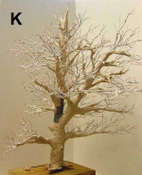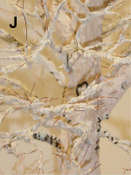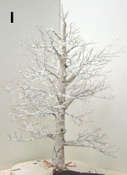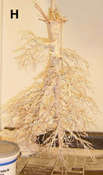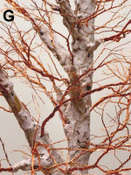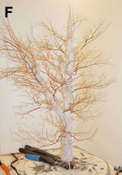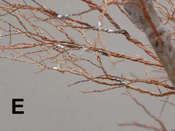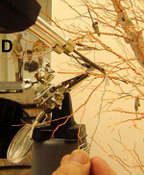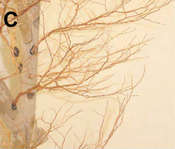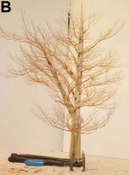1⁄35Super-tree or Super-nuts ?
16
Comments

"The Triorama"
For the last 11 years, on and off (mostly off), I have been building a “triorama”. A triorama, by my definition, is three scenes, not just one, and in this case, on a turntable, like three boxes in a cartoon strip. My triorama contains three scenes from the movie, “Kelly’s Heroes”.
Scene One
The first scene is the barn where Kelly is holding the gold bar he got from his (now drunk) German captive and he is pointing to a map. He is showing his squad the map and convincing them to “go for gold”. To see inside the farmhouse, a circular opening was made in the thatched roof.
To keep the scenes apart, I wanted eye blocks rather than partitions. I decided I had to have a tree that perfectly blocked the other scenes, without blocking the hole in the roof of the barn. So I jumped in. Using resources ranging from Osprey’s “Terrain Modeling” (with almost nothing they use available in the U.S.), notes from a model railroading class, to every other reference I had, the journey began. Twisted wire just didn’t do it. A practice tree twelve inches tall was too wobbly. No roots had the right shape. There was no easy was out. So, this is what I did …
Making The Tree
Picture A shows the dowel-in-dowel method. Wood dowels were tapered on a belt sander and pegged and epoxied into holes drilled at an angle into the trunk and limbs. This works for the main trunk and major limbs only. It’s rough looking. And had I known I was still over 100 hours away from finishing, I might have given up the ghost. But, sometimes ignorance is … ignorance. You sharp-eyes modelers will see that this picture was actually one of my earlier efforts and not shaped or angled like the final tree, but the process was the same. In the future, I would add some large diameter copper wire for reasons you’ll see later.
Picture B shows the tree skeleton with some 1/35th figures for reference and uncountable 7-copper wire strands, from an entire spool I bought, inserted into holes drilled into the end of the dowels and other random places along the major limbs and trunk. This photo was taken after I untwisted and re-twisted every one of the 7-wire strands. There were many nights where I “twisted the night away”. Every combination of individual wires from the 7-wire strands was used. From 6 and 1, then the 6 twisted into 4 and 2, or 3 and 3, or 5 and 1… Or, starting with 4 and 3, with the 4 reduced to 3 and 1 or 2 and 2… You get the picture. In some case, I had two or three wires strands to start from, so I had 21 or 14 individual wires to twist and twist into various other combinations, to give the realistic randomness of a real tree.
Picture C is a close-up of untwisted and retwisted wires. The black circles are where I marked places for the holes to be drilled and wires to be inserted. Every strand had to end up as an individual wire to replicate the twigs at the outer ends of limbs, branches, etc.
When I stood back and looked at it, it looked so puny I had my second crisis of confidence and left it alone and pondered and pouted. Finally, I got the idea to solder more strands on for fill. I just didn’t want to do the “stretch the poly-fiber” bit. Picture D shows me soldering on more strands, before my burns and wire poke holes and my Internet search for copper poisoning symptoms. You can see some clamps I used as “third hands” to hold strands together for soldering and to mark places where I needed more wire. More untwisting and twisting.
Next, Picture E is a close-up of the beefed up, or wired-up, branches.
Picture F is the tree plastered only over the wood dowels to create more natural curves between the dowels. Had I figured out how I was going to do the bark, I would have skipped this miserable step.
Picture G is a close-up. The beautiful, naturally irregular texture is testimony to my frantic attempt to get the plaster on before it set. So, at this point I could have said, “I did it on purpose”, but it was just an experiment.
Comments
That's what I like about our hobby. We can do what we want. Some dioramas are designed to be viewed in the round and some are like bas-relief, and some shouldn't be viewed from the back (some shouldn't be viewed from the front) and some are in shadow boxes.
The nightmare I started just got in my head, the three scenes, and 11 years later, I'm still putzing with it.
Sealhead
JUN 25, 2004 - 08:30 AM
Jeff,
Your diorama and tree look great. Thanks for the tree tutorial too. I was hoping I could squeeze one more bit of information from you.
The building in your diorama, is it a kit or built from scatch? If it is a kit can you give me some contact info of it's source.
Thanks,
Scott.
JUN 28, 2004 - 06:11 AM
Dear Scott,
The farmhouse was scratchbuilt. The roof was a nightmare of trial and error. The bank building (in front) and the railroad roundhouse (in back) of the same building was scratchbuilt. The water tower was scratchbuilt, but will be redone. The accessories in the farmhouse like milk cans, etc. was scratch. The figures were a combination of figure kits, swapping body parts like heads and hands, and repositioning them to have the pose I wanted. The railroad track was scratch.
The tree, as you know, was scratch, and all the weeds, grass, bushes, trees, etc. to come will be scratch.
Sealhead
JUN 28, 2004 - 08:53 AM
Dear Jeff,
If you don't mind my saying so, yes, super nuts is what you are (no offense meant). And that's what makes the thing (and the guy who created the thing) so great. You were nuts enough to begin the project, but you finished it. You didn't quit. You are an inspiration to all of us who fiddle with parts smaller than the average eye can see and create something out of virtually nothing. Thanks for the feature -- if the idea of the triorama, on its own, deserves a Best of Show, what more the tree?
Admiringly,
Andrew Oliveros
JUN 28, 2004 - 07:22 PM
Dear Andrew,
Very kind of you Andrew (I think). But, I'll feel better when I finish the darn thing. My target is when we host the Nationals in 2006, but even that is a push with everything else on my plate.
I don't mind being called "nuts". I've had professionals tell me that. I have been told my persistence makes up for my lack of ability. There you go.
Also, it is cool that 2500 people decided to peek at this project and better yet to put a little something back into Armorama.com because it has done so much for me.
Sealhead :-)
JUN 28, 2004 - 11:40 PM
I know how it is...but, way its been for me, you're never really done with any project -- every dio (or trio) or figgy or tank or plane or ship takes on a life of its own, wanting something extra to make it "just right", even if it's darn near perfect already.
Anyway, those who say your "persistence makes up for lack of ability" must be blind or envious. I know creativity when I see it. You have the gift, man. Don't let anyone tell you differently.
Great work. Here's to even greater work ahead.
JUN 29, 2004 - 04:05 PM
Wowzers, what a TREE!!!!
I dont do military scale dioramas, but 1:10 scale for model horses, or just my own scale for my animal sculptures. I have been wanting to do a nice tree for a while, and just happened upon this one while browsing. Nice work!!
AUG 23, 2004 - 08:24 PM
well i have been reading this post so many times before and also printed and checked it at home.
I dont know why i didnt post before ...maybe i was looking , just thinkin how carried away u can be with modelling doing a 3 scene dio for 11 years !!!!!!!!
What to say the text is so detailed and well describing and Jeff is so honest in telling all flaws and mistakes that happened to him . The result is superb and so its that tree. What else can i say ....
Costas
DEC 07, 2004 - 11:50 PM
UPDATE FROM SEALHEAD 12/8/04
I thought the tree was a bit skimpy. So, I am back at it. Here's a new tip. When you want to add additional copper wire to get a bushier armature, get a length twice as long as you want to add and join it to the existing "branch" at the middle of the new wire.
Then after a few twists, you can double back the bottom half of the new wire to make even more branches and twigs. Half the work and twice the twigs.
Sealhead
DEC 08, 2004 - 01:49 AM
Copyright ©2021 by Jeff Winkel. Images and/or videos also by copyright holder unless otherwise noted. The views and opinions expressed herein are solely the views and opinions of the authors and/or contributors to this Web site and do not necessarily represent the views and/or opinions of Armorama, KitMaker Network, or Silver Star Enterrpises. All rights reserved. Originally published on: 2004-06-20 00:00:00. Unique Reads: 36493





